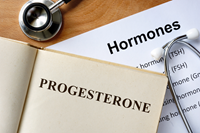Why do hormone changes in menopause increase cardiovascular risk?
Your Menopause Question: Why do hormone changes in menopause increase cardiovascular risk?
Our Response: Cardiovascular disease (CVD) risk from hormone changes in the menopause transition and early menopause begs the chicken and egg question: Which came first? It is a source of intense investigation since globally women’s deaths from heart disease are eight times that of breast cancer.
The decline and then loss of estradiol from the ovaries does seem to precipitate a constellation of events leading to metabolic syndrome, central obesity, alterations in lipids, elevated blood sugar, and increased cardiovascular risk. But, between the loss of estradiol and the emergence of metabolic syndrome, a number of integrated events unfold (Lobo, 2008).
Estradiol, produced exclusively by the ovaries, normally is metabolized by intestinal bacteria to its active form while maintaining a balanced healthy bacterial population (Becker, 2020). The bacteria protect the intestinal lining whose immune and neural system analyzes food intake and dictates, via signals from the intestinal parasympathetic nerves to our brainstem, the maintenance of energy expenditure and activity (Duval, 2013).
Loss of estradiol initiates a number of hormonal changes linked to cardiovascular health. The bacterial populations change, leading to intestinal inflammation and damage to the cohesiveness of cells within the intestinal wall. The more porous intestinal lining increases abnormal nutrient absorption and signals the brainstem to reduce energy expenditure and physical activity (Muller 2020). The result is deposition of visceral fat and obesity. The visceral fat, a prime source of oxygen free radicals and free fatty acids, feeds these inflammatory products into the liver, which results in fatty liver deposits and increased insulin resistance with altered glycogen/glucose metabolism (Karvonen-Guttierrez, 2016). But how does fatty liver lead to lipid abnormalities and cardiovascular risk?
Cholesterol and the lipid profile often get a bad rap. Cholesterol, produced in the liver, is either free or stored as cholesteryl ester, linked to a long-chain fatty acid. Since both lipids are insoluble in aqueous blood plasma, they must be transported with a non-polar lipoprotein consisting of one or more specific apoproteins, the protein component of the lipoprotein. Apoprotein B is in low-density lipoprotein (LDL), while alpha lipoprotein is in high-density lipoprotein (HDL) (Botham, 2012).
Cholesterol normally is important for maintaining cellular membrane permeability, fluid dynamics, and provides the outer layers of plasma lipoproteins. LDL supplies cholesterol and its cholesteryl esters to many of our tissues. HDL removes cholesterol from our tissues and transports it to the liver for elimination or conversion to bile acids (Botham, 2012).
In animal models, estradiol normally lowers total and LDL cholesterol and increases HDL cholesterol and triglycerides. Moreover, in the liver, cholesteryl ester formation and elimination are controlled by cholesterol 7 alpha hydroxylase (C7H) and acetyl-coenzyme A; cholesterol acyltransferase (ACPT) 1 and 2 (Kavanah, 2009). ACPT 2 especially incorporates cholesteryl esters into apoprotein (APO) B-containing lipoproteins. Since estradiol reduces ACPT2, its protection against coronary plaque formation may be by reducing ACAT2 in hepatocytes and decreasing production of cholesteryl esters that otherwise get secreted into APO B-containing lipoproteins.
In the end, the chicken or the egg question is irrelevant. The loss of estradiol in menopause is undeniable. And the risk of metabolic syndrome on cardiovascular health is well established (Lobo, 2008). Out of this complex network of biologic events, there is one controllable concept. Lifestyle change, which means controlling one’s diet, smoking, alcohol intake, and maintaining daily exercise, provides a defense against life’s cardiovascular risks for midlife women.
James Woods | 9/16/2021




